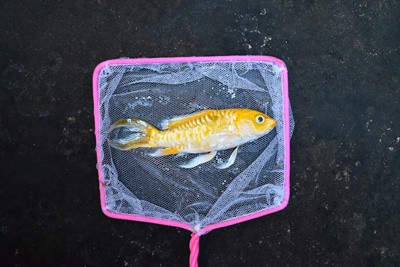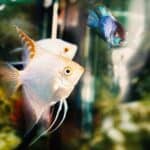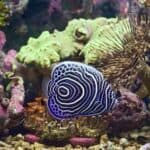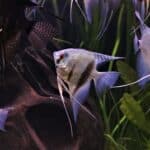Keeping a fish tank clean is essential. Improper conditions affect the tank’s ecosystem and surviving fish. So, you’ll need to know what to do when a fish dies in an aquarium.
The tank should be sterilized when a fish dies to prevent poor water conditions and contagious diseases from passing to healthy fish.
A 10-20% water change should be enough if the ammonia levels are stable.
To thoroughly clean the tank, make a solution of one part bleach and one part water and scrub the tank, including artificial plants and removable, non-porous items.
When you have many plants and decorative features in the tank, dead fish aren’t always easy to spot and remove. Monitor the tank’s conditions for changes.
If the ammonia levels rise without reason, one fish will likely have died.
How To Clean A Fish Tank After A Fish Has Died
Even if only one fish dies and the others seem okay, clean the tank in case of a parasite or disease.
You may not need deep sanitization if the tank’s ammonia and nitrite are safe. However, you must still check the aquarium’s cleanliness using testing strips or a similar device.
To clean and sterilize an aquarium after one of the fish has died, follow these steps:
Remove The Dead Fish
Once you notice a dead fish in the tank, remove it to prevent the conditions from deteriorating.
Similarly, the rest of the tank is at risk if the fish die from a disease or bacterial condition. There may be instances when you notice a fish is missing, but you can’t find its body. This is likely because:
- The fish is stuck or missing within the tank.
- The other fish have eaten it.
- The fish jumped out of the water.
Where there’s a body, scoop the dead fish out of the tank with a net and put it into a plastic bag.
You could put the fish in a waste bin. On a hot day, the fish will attract flies, causing unsanitary conditions. While it’s the easiest way to dispose of your fish, avoid throwing it in the garbage if it sits there for days.
Alternatively, you could bury the fish in the yard, which feels more personal and hygienic.
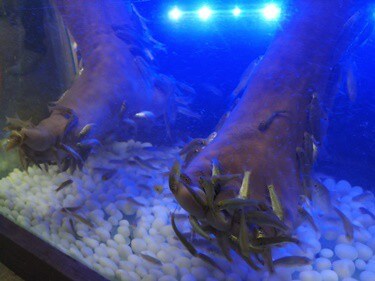
Check The Ammonia Levels
Depending on how long the fish has been left decomposing, the ammonia within the tank could rise to dangerous levels. Smaller tanks with more fish will experience rising ammonia much sooner.
Ammonia is dangerous to fish. If the tank’s ammonia and nitrite levels are too high, you must disinfect the tank and replace the water. Perform a standard water change if they’re at a normal level.
Test ammonia levels using a liquid water test kit or test strips.
Change The Water
As mentioned, a water change is sufficient to sanitize the tank if one fish has died, but the decomposing body hasn’t affected the water’s chemical balance.
Draining the water is not advised when other healthy fish are in the tank. Instead, carry out a water change when one of your fish has died, replacing 10-20% of the tank’s water.
To perform a water change, follow these steps:
- Remove the water using a jug, pouring the water into a bucket.
- Scrub the tank’s sides using an algae brush or magnet to remove bacteria and algae.
- Remove the artificial plants and ornaments and scrub them with the same algae brush.
- Siphon out any waste that has settled on the substrate.
- Clean the filter, swooshing it in the tank’s water to keep the beneficial bacteria.
- Add clean water and a dechlorinating solution, following the instructions carefully.
While you shouldn’t use bleach in a tank containing healthy fish, you may want to remove the decorations and small parts to sanitize them with a bleach solution.
Disinfect The Tank
If the water quality has deteriorated due to the dead fish, you must disinfect the tank to remove all traces of bacteria and ammonia if all fish inside the tank have died.
According to the American Association for Laboratory Animal Science, laboratories studying fish must be cleaned and disinfected to minimize the spread of pathogens and the buildup of waste products.
A natural vinegar solution is sufficient for standard aquarium sanitation. However, if the fish were struck down by sickness or disease, you must use bleach to kill the pathogens.
Follow these methods for a clean, sanitized tank:
Bleach Solution
Standard household bleach is potent enough to sanitize the tank against bacteria. Don’t use bleach mixed with other detergents, as it could corrode the tank.
Tank components safe to clean with bleach include:
- Aquarium glass and Plexiglas.
- Filter hoses.
- Non-porous parts.
- Artificial plastic plants.
- Gravel substrate.
- Rocks.
Before cleaning, create a solution of 8 parts water to 1 part bleach. Use warm water to allow the bleach to dissolve. Then, follow these steps:
- Move the surviving fish to a separate tank.
- Put the bleach solution into a standard spray bottle. Spray inside the tank and wait for 10 minutes.
- If the tank is particularly grimy, fill the entire aquarium with your bleach solution using the 8:1 rule.
- Rinse the tank and let it air dry for 24 hours.
- Once the tank is dry, fill it with water.
- Add a dechlorinator to purify the water and leave it for several hours.
- Empty the tank for a final time and re-add the dechlorinator to the fresh water.
After following these steps, the tank is ready. Remember, clean ornaments and decorative features using the bleach solution and a small brush.
Vinegar Solution
Bleach is corrosive and risks ruining the tank if misused.
You can clean the tank with a natural vinegar solution if the fish perished naturally and not due to disease. To do so, follow these simple steps:
- Move the fish into a separate tank.
- Create a solution of 1 part water to 1 part white vinegar.
- Take all decorations and removable parts from the tank and soak them in the solution.
- Fill the entire tank with the vinegar solution.
- After a couple of hours, remove the water and items from the solution.
- Rinse everything. If you notice some items still have buildup, make a more potent solution with 2 parts vinegar to 1 part water, leaving it to soak for longer.
Because white vinegar is less corrosive than bleach, you can soak the items for as long as necessary.
What Tank Problems Do Dead Fish Cause?
Dead fish cause sanitation problems, which can quickly escalate if the fish isn’t removed. The tank needs a deep clean to sanitize it from harmful chemicals and pathogens.
High Ammonia Levels
If the fish tank is cloudy after the fish dies, it’s likely because the ammonia levels have risen too high.
It also indicates that a dead fish has been inside the tank too long—cloudy water results from bacteria bloom, which means an imbalance of bacteria.
In a tank with normal conditions, beneficial bacteria reduce the tank’s ammonia. Similarly, live aquarium plants absorb ammonia and nitrite compounds, using them as a food source.
When a fish dies, the body releases too much ammonia, which neither the bacteria nor the plants can control. If this is left to continue, fish become poisoned by the ammonia. Symptoms include:
- Infections.
- Blindness.
- Recurring sores.
- Compromised immune system.
- Difficulty breathing.
- Torn fins.
Therefore, remove dead and decomposing fish immediately.
Disease Transmission
Many diseases can affect other fish in the tank, even after the host fish has died. Many parasites leave the fish searching for another host to infect, eventually causing the entire tank to succumb.
Disease-causing bacteria and parasites only exit the tank via a deep clean. A simple water change is unlikely to be sufficient to save your fish. Contagious diseases include:
Some fish cannibalize their dead kin so they can get sick from diseases the fish is carrying.

Stress
When dead fish are left floating in the tank, other fish may become stressed by the dead body.
According to the Journal of Ethology, researchers discovered that fish form an attachment to their tankmates in as quickly as ten days.
Consequently, while fish aren’t likely to grieve, they may be able to recognize the death of a familiar.
The physical signs of stress include:
- A color change, whether it becomes darker or lackluster.
- Unusual red streaking on the fins.
- White spots on the body indicate a parasitic or fungal infection.
Behavioral signs of stress include:
- A loss of appetite.
- Darting randomly across the tank.
- Heavy breathing.
- Gasping for air.
- Hiding for long periods.
- Lack of activity.
- Scraping against the tank’s bottom.
- Strange swimming patterns.
Dead fish cause the tank’s conditions to deteriorate, which is another reason for stress. There’s also reason to believe that fish know when another fish has died, which is also stressful.
Keeping the tank clean is vital to keeping the fish happy, especially after one has died. You may not know what caused the fish’s death, meaning the water could be compromised.
If you have lots of plants and hiding places in the tank, keep an inventory of the fish and perform a regular headcount to determine whether any have died.
Always check the aquarium’s ammonia levels in case they start to rise.

